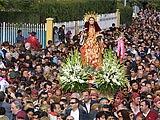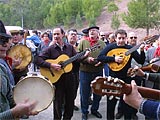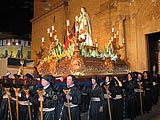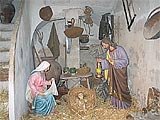
Fiestas En Honor De Santa Eulalia (Festivals in honour of Saint Eulalia)
Romeria De La Santa (Pilgrimage of the Saint)
Carnavales (Carnival)
San Marcos (Saint Mark)
Semana Santa (Easter)
Fiestas En Honor Al Patron Santiago Apostol (Festivals in honour of Patron Saint James the Apostle)
Fiestas De S. Roque (Festivals in honour of Saint Roque)
Fiestas De Navidad (Christmas)
(Festivals in honour of Saint Eulalia)
(December 8, 9 and 10)
 These
festivals begin with a pilgrimage in which the image
of 'Santa Eulalia' is taken from the retreat
in the mountain to that of 'San Roque'. Later,
the image is taken to the church of 'Santiago'
(Saint James), when a procession also takes place.
These
festivals begin with a pilgrimage in which the image
of 'Santa Eulalia' is taken from the retreat
in the mountain to that of 'San Roque'. Later,
the image is taken to the church of 'Santiago'
(Saint James), when a procession also takes place.This pilgrimage dates back to the seventeenth century when people from Totana and other places, attracted by news of the many miracles performed by the Saint, began to go along to the mountain retreat. As the place itself was gloomy and it was a cold time of year, the people sheltered inside the retreat, where stewards brought them food and drink, and they spent the night singing and dancing.
Now, as in the past, on the night before, people
from Totana and the surrounding area, who hold a
special affection for both the mountain and the
Saint, arrange to meet at the foot of the mountain
to spend the night in good company and to enjoy
'migas' (a typical hearty dish of fried
breadcrumbs) and good wine whilst they wait for
daybreak. The image is taken out of the retreat
by bearers, who carry it on their shoulders, in
the early hours of the morning. Barefoot devotees
and merry pilgrims show their devotion to the Saint
by accompanying her on her journey with euphoric
religious chants, which can only be heard at times
like this.
The journey of the Saint through 'Los Huertos'
is charming and emotive, especially when the followers
draw near to the image and cheer her in passing,
whilst those who carry the Saint give out sweets
to the people who have spent a long night outdoors.
The pilgrimage continues in this fashion until it
arrives at a place, which has long since been known
as 'El Rulo', where the image is received
by the townspeople and the civil and ecclesiastical
dignitaries alike, who then accompany their patron
to the end of her pilgrimage, which is found at
the retreat of 'San Roque'.
Romería
de la Santa
(Pilgrimage of the Saint)
(January 7)
 This
is the date on which the people of Totana hold their
traditional pilgrimage when the image of 'Santa
Eulalia', accompanied by a great procession,
is returned to her retreat in the mountains from
the parish church of 'Santiago' (Saint
James).
This
is the date on which the people of Totana hold their
traditional pilgrimage when the image of 'Santa
Eulalia', accompanied by a great procession,
is returned to her retreat in the mountains from
the parish church of 'Santiago' (Saint
James).
The festivities begin early in the morning at nine
o'clock when both pilgrims and local dignitaries,
in the same state of excitement, commence the pilgrimage
towards the retreat. Once they arrive at 'El
Rulo', the authorities bid goodbye to the Saint,
whilst the pilgrims continue their ascent of the
mountain, all the way singing and dancing to the
sound of guitars and castanets and, more importantly,
drinking 'mantellina' to keep out the cold.
Once at the summit, they prepare themselves for
the descent with a typical dish of rice and rabbit,
which is cooked and eaten al fresco.
Carnavales
(Carnival)
(February-March)
I have always had a feeling that I was being hard done by when it came to Shrove Tuesday. I had been aware for many years of the Carnival in Rio de Janeiro and Mardis Gras in New Orleans which celebrated the last day before lent in a slightly more exuberant way than eating a pancake that my mother had often stuck to the ceiling in a pretty poor display of tossing or had peeled off the floor, made a token effort to scrape off the dog hairs now attached to it, and tell me with no authority whatsoever “that won’t kill you, get it down you”.
When I first moved to Totana I was blissfully unaware that in this small town of some 30,000 people they too host an amazing celebration which goes largely unseen by outsiders eyes. Groups of people called Peñas come together early in the New Year and start to rehearse with absolute dedication for their performances. The rehearsals are frequent and intensive and the hard work can be seen in the level of their performances. The eagle eyed among you will notice that I have used the plural form of performance. There’s a reason for that, in Totana the Carnival happens twice. Once on the Saturday before Shrove Tuesday and then again the following Saturday when they invite the best of the best Peñas from surrounding towns to come and join the party.
The Peñas differ in size and in the level of seriousness with some being a mere handful of characters on a small float to dance troupes of nearly 200. There is a cross section of ages and genders, the men are heavily involved in every area of the Carnival, and there is also a specific childrens Carnival on the Sunday. The larger Peñas will often tell a story through their dance and competition to be the best Peña is fierce. Costumes, hair designs and make-up are elaborate. Parents have no objections to spending up to €1500 on an outfit that will only be worn for one years Carnival. Each Peña has it’s own floats and vehicles and the music which accompanies the troupes is loud and infectious.
So, let’s get on to the first day of Carnival and try to imagine that the whole town either seems to be taking part in the show or watching it. Viewing points are at a premium, it’s quite normal to see people arriving on the route with their sofa. Did you read that ? They bring their bloody sofa with them !! Well, they usually have the last laugh, if you stand in one spot the whole procession will take about 4 hours to go past you. This type of commitment to watching an event generally requires a drink or two and the bars are busy and incredibly good natured. This town knows how to party and, more importantly, it knows how to behave. There is a token local police car at the head of the procession and then after that there is no visible presence whatsoever. It seems unbelievable but it’s true, the whole event needs absolutely no policing and everywhere you look for the whole day there are people with a drink in their hand.
If you have never been to see Carnival then you’re in for a real treat. For many, myself included, it’s one of the best weekends of the year. Now I’m not going to tell you where I watch it from but let’s just say the plaza is a fantastic spot to take everything in. Bring chairs if you want to and above all else bring a happy heart and watch a small town celebrate like there’s no tomorrow………. anyone for pancakes?
Carnival 2020 will be on 22nd and 29th February.
San Marcos
(Saint Mark)
(April 25)
This festival takes place on April 25, with the day traditionally being spent in the countryside and people enjoy the typical dish of 'garabazos'.
Semana Santa
(Easter)
(March-April)
 Spring
starts with Easter. This long-standing and traditional
religious festival is vibrant and colourful and
the people of Totana expectantly await its coming
and the opportunities it affords to don hoods and
tunics and to take part in the processions or simply
to watch their passing from squares and balconies.
The bands of drums and horn players lend an air
of solemnity to the occasion. Another special feature
of Easter Week are the 'Armaos', a group
formed in the eighteenth century by 'Don Alonso
Ramón Cánovas'. This group was
initially made up of eighteen men, all from important
families of Totana, and they dressed according to
the Roman fashion, and today this same group escorts
the thrones of 'Nuestro Padre Jesús'
(Jesus Our Father) and 'El Santo Sepulcro'
(The Holy Tomb) in the procession which takes place
on the night of Good Friday. Totana takes on an
air of special beauty during these spring days and
it makes a splendid setting for the numerous processions
that take place during the week. A great many of
the inhabitants of Totana take part in the Easter
celebrations, there are sixteen brotherhoods, some
of which date back to the eighteenth century, with
more than 3000 members in all, of which 390 are
female. These women belong to 'Nuestra Señora
de la Esperanza' (Our Lady of Hope) and they
take part in the Silent Procession on the Wednesday
before Easter arrayed in the Español mantilla and
scapular and they carry a rosary and a short staff.
Spring
starts with Easter. This long-standing and traditional
religious festival is vibrant and colourful and
the people of Totana expectantly await its coming
and the opportunities it affords to don hoods and
tunics and to take part in the processions or simply
to watch their passing from squares and balconies.
The bands of drums and horn players lend an air
of solemnity to the occasion. Another special feature
of Easter Week are the 'Armaos', a group
formed in the eighteenth century by 'Don Alonso
Ramón Cánovas'. This group was
initially made up of eighteen men, all from important
families of Totana, and they dressed according to
the Roman fashion, and today this same group escorts
the thrones of 'Nuestro Padre Jesús'
(Jesus Our Father) and 'El Santo Sepulcro'
(The Holy Tomb) in the procession which takes place
on the night of Good Friday. Totana takes on an
air of special beauty during these spring days and
it makes a splendid setting for the numerous processions
that take place during the week. A great many of
the inhabitants of Totana take part in the Easter
celebrations, there are sixteen brotherhoods, some
of which date back to the eighteenth century, with
more than 3000 members in all, of which 390 are
female. These women belong to 'Nuestra Señora
de la Esperanza' (Our Lady of Hope) and they
take part in the Silent Procession on the Wednesday
before Easter arrayed in the Español mantilla and
scapular and they carry a rosary and a short staff.
Also dating back many years are the processions
which take place on the Thursday before Easter and
Good Friday. The brotherhoods carry adorned thrones
and images such as that of 'Nuestra Señora
de los Dolores' (Our Lady of Sorrow) which
has a beautiful robe embroidered in gold and is
accompanied by a marching band made up of violins,
wind and percussion instruments. The standards,
some of which are extremely old, are carried before
the thrones and they lend a splash of colour to
the proceedings. The festivities in Totana come
to an end on Easter Sunday, with an emotive procession
which depicts the Resurrection.
These festivals have been declared of 'Interés
Turístico Regional' (of special interest
to visitors to the region).
Fiestas en
honor al Patron Santiago Apóstol
(Festivals in honour of Patron Saint James the Apostle)
(July 23, 24 and 25)
Traditionally, cultural events of great prestige are held in Totana during these few days such as the famous musical 'Certamen Internacional de Habaneras' (International Contest of Habaneras) in which choirs from different parts of the region participate. There are also religious celebrations, of which the most important is undoubtedly the procession of the patron saint.
Fiestas de
San Roque
(August 15-16)
Religious acts take place at this time of year which culminate in the procession of the Saint. There are also cultural and traditional celebrations such as the popular open-air parties which create a highly festive atmosphere.

